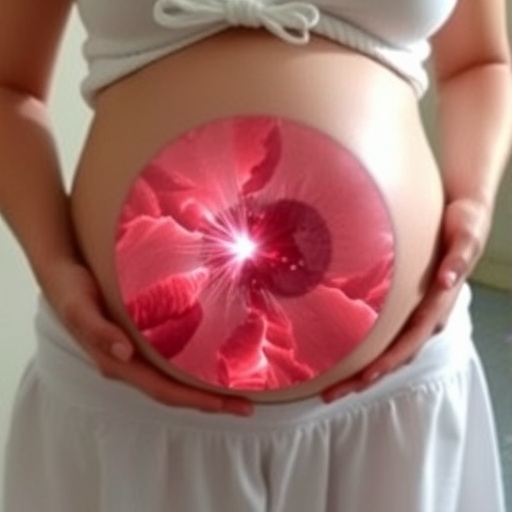A Rare and Aggressive Entity: Unraveling the Mysteries of Pure Non-Gestational Ovarian Choriocarcinoma
In a groundbreaking case report published recently in the esteemed journal Oncoscience, researchers have brought to light an extraordinarily rare and aggressive form of ovarian cancer known as pure non-gestational ovarian choriocarcinoma (NGOC). This tumor subtype, which accounts for less than 0.6% of malignant ovarian germ cell tumors, primarily afflicts young women and poses significant clinical challenges due to its diagnostic complexity and aggressive biological behavior.
The case, meticulously documented by a team led by Dr. Naina Kumar at the All India Institute of Medical Sciences in Bibinagar, details the clinical journey of a 36-year-old woman who presented with persistent abnormal vaginal bleeding over several months. The initial clinical assessment and a positive pregnancy test steered the diagnostic consideration towards an ectopic pregnancy, a more common and pressing gynecologic emergency. However, advanced imaging modalities, including transabdominal sonography, revealed a well-demarcated, solid-cystic adnexal mass measuring approximately 10 centimeters, with prominent vascularized solid areas and zones indicative of intralesional hemorrhage.
This sonographic appearance, while raising suspicion for gestational trophoblastic disease, required further molecular characterization to ascertain the tumor’s origin. Given the overlap in clinical and laboratory features between gestational and non-gestational choriocarcinomas—specifically the markedly elevated levels of beta-human chorionic gonadotropin (β-hCG), a hormone typically associated with pregnancy—the differentiation is far from trivial. The definitive diagnosis hinged upon genetic analysis of the excised tumor tissue, which unequivocally confirmed the absence of paternal DNA, establishing the tumor as purely non-gestational in origin.
The distinction between gestational and non-gestational choriocarcinomas is clinically paramount. Unlike their gestational counterparts, which arise from trophoblastic cells following conception and typically respond favorably to chemotherapy regimens, NGOCs are of germ cell derivation and notoriously exhibit aggressive clinical courses, often resistant to conventional therapeutic approaches. This patient underwent radical surgical management entailing hysterectomy, bilateral salpingo-oophorectomy, and regional lymphadenectomy aimed at maximal cytoreduction.
Post-surgical intervention, the patient received systemic chemotherapy incorporating a regimen of Bleomycin, Etoposide, and Cisplatin (BEP), agents known for their efficacy against germ cell tumors. Impressively, after two standard cycles, her β-hCG levels normalized, indicating a robust biochemical and clinical response to treatment. Ongoing surveillance involving serial hormone monitoring and imaging studies aims to detect early recurrences, a crucial aspect given the tumor’s aggressive nature.
This case underscores the inherent diagnostic challenge posed by NGOCs, whose clinical presentation mimics more prevalent reproductive tract conditions such as ectopic pregnancy or gestational choriocarcinoma. The reliance solely on clinical assessment and routine laboratory findings risks misdiagnosis and delayed treatment, compounding morbidity risks. The integration of advanced imaging, histopathological evaluation, and especially molecular genetic profiling emerges as a critical triad for precise diagnosis.
Moreover, this report adds vital data to the scant existing literature on pure NGOCs, propelling understanding of tumor biology, optimal therapeutic strategies, and prognostic determinants. It calls for heightened vigilance among clinicians to consider rare germ cell tumors in differential diagnoses, particularly in patients with atypical presentations and unresolving clinical scenarios despite standard management.
The molecular insights gained from this case highlight the importance of characterizing tumor DNA content, providing a blueprint for future personalized medicine approaches. Understanding the tumor’s genesis at a genetic level may pave the way for targeted therapies that transcend the conventional chemotherapeutic paradigm, potentially improving survival outcomes in this vulnerable patient cohort.
From a pathological standpoint, NGOCs demonstrate aggressive invasive features and pronounced vascularity, frequently accompanied by hemorrhagic necrosis within the tumor mass. These attributes contribute to the clinical symptoms of bleeding and pain, serving as important imaging and histological clues. Radiologists and pathologists must maintain a high index of suspicion when encountering vascularized ovarian masses with elevated β-hCG, especially in non-pregnant women.
The therapeutic response observed in this patient offers a cautiously optimistic outlook, demonstrating that early, aggressive multimodal treatment can achieve remission in NGOC, a tumor historically associated with poor prognosis. Nonetheless, long-term follow-up remains indispensable to identify and manage relapse promptly.
In conclusion, this illuminating case from AIIMS Bibinagar not only enriches the medical community’s comprehension of a rare ovarian malignancy but also accentuates the critical role of multidisciplinary collaboration in tackling enigmatic oncologic entities. As the quest for enhancing diagnostic precision and therapeutic efficacies continues, such detailed case studies serve as invaluable beacons guiding future research and clinical practice.
The ongoing dissemination of knowledge through open-access platforms like Oncoscience fortifies the global effort against rare cancers, ensuring equitable access to life-saving scientific advancements regardless of geographic or economic barriers. This case stands as a testament to the triumph of meticulous clinical investigation, sophisticated diagnostic tools, and tailored therapeutic regimens in combating one of the most daunting challenges in gynecologic oncology.
Subject of Research: People
Article Title: A rare case of pure non-gestational ovarian choriocarcinoma: Diagnostic mimicry and management strategies
News Publication Date: 28-Jul-2025
Web References:
http://dx.doi.org/10.18632/oncoscience.622
Image Credits:
Copyright: © 2025 Kumar et al. This is an open access article distributed under the terms of the Creative Commons Attribution License (CC BY 4.0).
Keywords: cancer, chemotherapy, ectopic pregnancy, germ cell tumor, gestational ovarian choriocarcinoma, non-gestational ovarian choriocarcinoma




